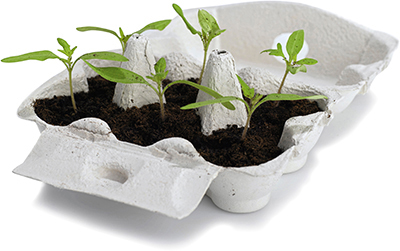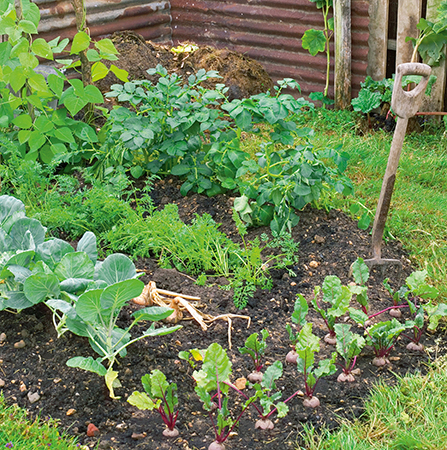
Plant greens in the sunniest and flattest part of the garden to ensure a good supply of vegetables throughout the summer and fall. Plan vegetable and lettuce beds well so that they are easy to maintain, accessible for weeding and watering and protected against garden invaders.
How you plan your beds will help you immensely in the long run. It will save time and effort, make it easier to harvest crops and could prevent you from developing a sore back.
USE CARDBOARD egg cartons for STARTING SEEDLINGS.
Keep vegetable beds no wider than 4 feet (1.2 m) and for accessibility, don’t place them right next to a wall or a hedge. The paths between individual beds should be about 12 inches (30 cm) wide.
• Lay wood boards on the paths so you won’t sink into the mud during rainy weather.
• Remove all roots of perennial weeds before you plant. Dig the soil well.
• Divide the vegetable bed into two: one with things you harvest daily, such as carrots, radishes and lettuce; the other with permanent crops, such as herbs and horseradish, cabbages and asparagus, and with crops such as potatoes.
• In cool climates, use berry and hazelnut bushes to provide attractive protection against cold wind.
• Plant potatoes and Jerusalem artichokes to loosen the soil and restrict weeds.
• Add basic fertilizer, preferably with compost, about 3 weeks before the first planting.
• Plant low-growing vegetables on the sunny side of taller ones so they get adequate light.
• Allow for varying ripening times when you are laying out the bed, so you can grow different plants close together.

This small vegetable bed is located next to the compost heap, making it easy to fertilize.
• Use plastic starter trays. They are easy to clean, which makes it difficult for diseases to take hold.
• Don’t forget to label individual starter trays with the name of the vegetable and the date of planting.
• Don’t plant too many seeds in one tray. The fewer seeds you plant in a container, the less work you’ll have when it’s time to thin out the plants.
• Sow larger seeds farther apart, singly or in pairs, just in case one of them fails to sprout.
• Scatter smaller seeds, such as spinach and Swiss chard, directly into shallow furrows in the bed. Cover them lightly with soil.
• Mix very small seeds with a little sand so they don’t fall too close together when you are sowing them and are easier to spread.
• Soak the seeds from legumes or vegetables such as pumpkins or tomatoes (which are really fruit) in a milk marinade for 24 hours so that they will sprout faster.
• Warm the ground by covering it with a black tarpaulin or black plastic sheet for a week in advance and you can seed outdoors earlier.
• Plant zucchini and cucumber seeds on their sides to speed germination.
• Make optimal use of space by planting slow-growing vegetables such as carrots between fast-growing lettuce.
• Dig irrigation ditches between rows to let the water soak in slowly and reach the roots. This works well for any vegetable best watered from below, such as brussels sprouts.
• Make sure the water is warm to the touch or plants will get a real shock in hot weather.
• Dig green manure, such as clover, alfalfa and vetch, into the soil in the autumn. This provides a natural source of nutrients.
• In late autumn, enhance the soil in harvested beds by adding mulch or digging in manure.
• Plant aromatic herbs or flowers around the vegetable patch, such as dill, alyssum, cornflower and French marigold, to attract useful garden visitors such as ladybugs and dragonflies.
• Pick off harmful pests such as caterpillars and snails individually. Snails tend to lurk in grass, so keep the lawn around the vegetable patch cut short.
• If bushes or hedges near the garden are infested with aphids, protect vegetables with garden fleece.
• Install chicken wire or netting over a freshly sown bed to keep cats and birds at bay. Once the tender shoots have emerged, use it to make a fence around them.
• Make a scarecrow by hanging shiny objects such as CDs or foil containers from branches or a forked pole stuck into the ground. They will reflect the sunlight as they move in the wind, helping to frighten away hungry birds.
A herbal extract for seedlings
1/4 cup (50 g) dried nettles
2 teaspoons (10 g) sage
2 teaspoons (10 g) rue
2 teaspoons (10 g) artemisia
4 teaspoons (20 g) ferns
4 teaspoons (20 g) onion peelings
10 quarts (10 L) water
Soak the herbs, ferns and onion peelings in water for 24 hours, then boil and strain. Dilute the completed slurry 10:1 and sprinkle on the seedlings to strengthen them. Repeat this application weekly.